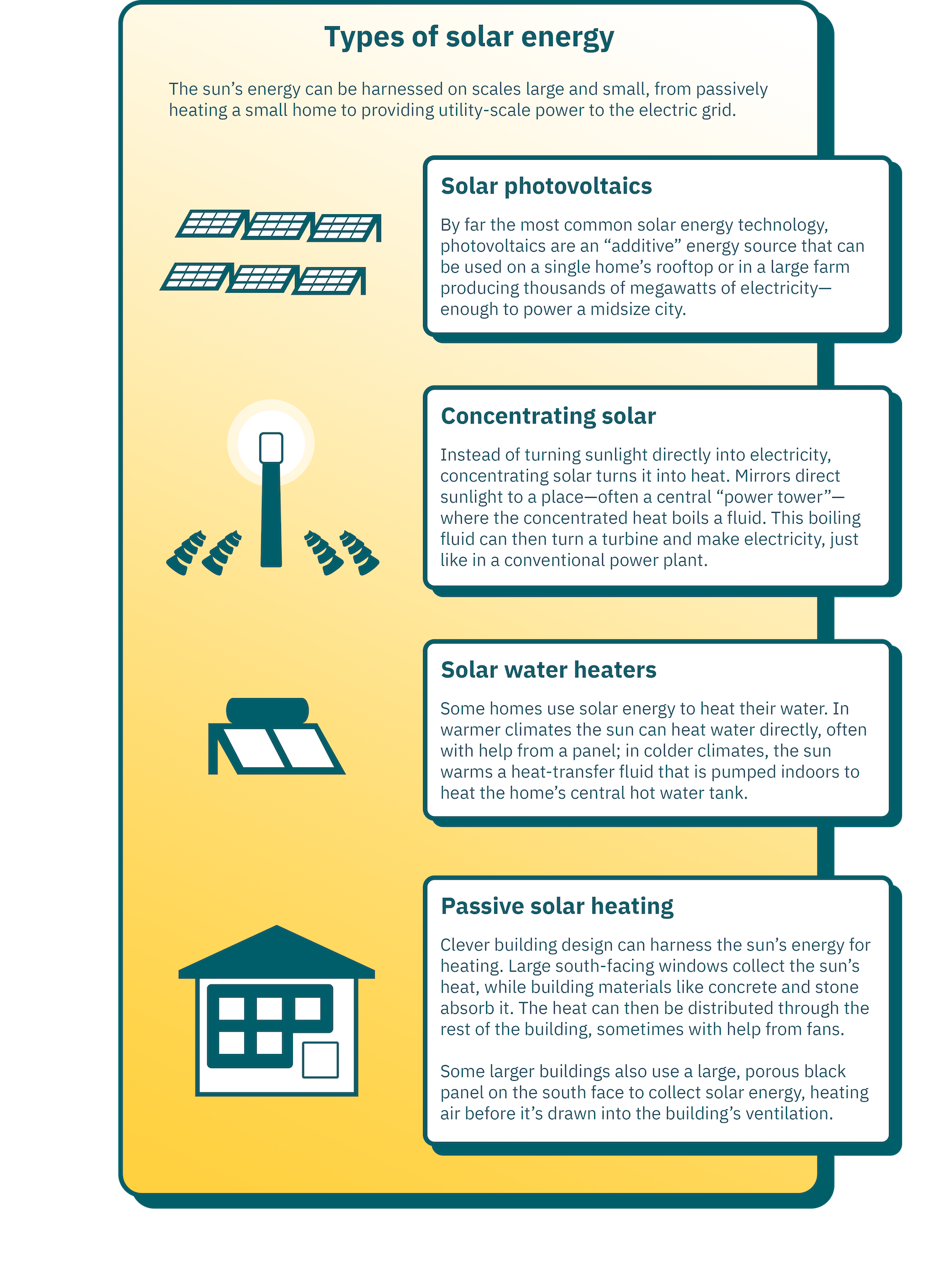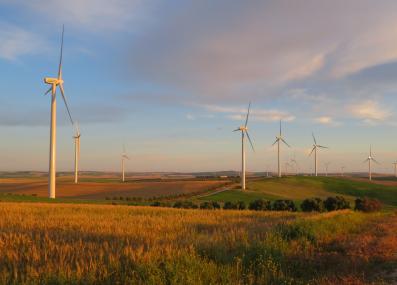New to Climate Change?
Solar Energy
Solar energy is a form of renewable energy, in which sunlight is turned into electricity, heat, or other forms of energy we can use. It is a “carbon-free” energy source that, once built, produces none of the greenhouse gas emissions that are driving climate change.
Solar is the fastest-growing energy source in the world, adding 270 terawatt-hours of new electricity generation in 20221: enough to power a midsize state like North Carolina or Michigan,2 or a small wealthy country like Denmark or Ireland.3
The solar photovoltaic effect
There are several ways to turn sunlight into usable energy, but almost all solar energy today comes from “solar photovoltaics (PV).”
Solar PV relies on a natural property of “semiconductor” materials like silicon, which can absorb the energy from sunlight and turn it into electric current. When light hits a semiconductor, it knocks the electrons in the semiconductor’s atoms loose. The electrons then move freely until they find another atom that can take them in, generating an electric field that forces electrons to flow in a specific direction.
The solar panels (“modules”) you see on homes and in solar farms are made of many “cells” of silicon or other types of semiconductor, which constantly absorb light and release electrons. The cells are specially treated and arranged so the free electrons, the “electric charge,” all move in the same direction. This creates an electrical current that can be used to power homes, electric vehicles, and anything that runs on electricity.
The first solar panels were built in the 1950s. They were expensive to make and turned less than 10% of the sunlight that reached them into electricity, making them useful only in situations where no other fuel could be had—like in satellites and spacecraft. But over time, engineers learned to build more efficient panels and invented cheaper PV chemistries, and factories began making solar panels at a huge scale. As a result, the price of solar energy has fallen over 500-fold since 1975 and around 90% just since 2010.4
Solar in the larger energy system
Today, solar PV is one of the cheapest sources of new energy being built, second only to wind energy.5 The International Energy Agency forecasts that solar will be the largest source of energy in the world before the end of this decade, and rates it as the only energy-generating technology whose growth is “on track” to meet the world’s climate goals.1
A unique advantage of solar PV is that it’s easy to scale up or down. The same panels work equally well in an immense solar farm providing energy to the electric grid, or on a rooftop powering a single house.6 Homeowners looking to save on their energy bills, remote hospitals in low-income countries who can’t rely on the electric grid, and communities who want a backstop during blackouts all value solar energy because it can be built in small, local installations that would be impractical with other energy technologies.
Nonetheless, solar energy, on its own, can’t be relied on around the clock. It is a “variable” energy source that generates more electricity on sunny days, less on cloudy days, and none at night. An electric grid with lots of solar power must pair it with other technologies for reliability: energy sources like hydropower that can be powered up and down at will, energy storage (like batteries) to save up solar energy when it’s plentiful, and/or long-distance transmission to move electricity from the sunniest spots to where it’s needed.
Scientists and engineers also continue to improve solar technology. Many focus on making solar PV cells thinner, lighter, flexible, and transparent. This could let users install solar PV in new places, like on windows. It could also drive down costs. Already, solar panels themselves account for less than half the cost of large solar farms and a tiny fraction of the cost of small rooftop projects,7 so lightweight technologies that save on labor, transportation, and land use costs could make solar energy even cheaper and more accessible.

Click here to see information from the infographic above in a table.
| Type of solar energy | Description |
|---|---|
| Solar photovoltaics | By far the most common solar energy technology, photovoltaics are an “additive” energy source that can be used on a single home’s rooftop or in a large farm producing thousands of megawatts of electricity—enough to power a midsize city. |
| Concentrating solar | Instead of turning sunlight directly into electricity, concentrating solar turns it into heat. Mirrors direct sunlight to a place—often a central “power tower”—where the concentrated heat boils a fluid. This boiling fluid can then turn a turbine and make electricity, just like in a conventional power plant. |
| Solar water heaters | Some homes use solar energy to heat their water. In warmer climates the sun can heat water directly, often with help from a panel; in colder climates, the sun warms a heat-transfer fluid that is pumped indoors to heat the home’s central hot water tank. |
| Passive solar heating |
Clever building design can harness the sun’s energy for heating. Large south-facing windows collect the sun’s heat, while building materials like concrete and stone absorb it. The heat can then be distributed through the rest of the building, sometimes with help from fans. Some larger buildings also use a large, porous black panel on the south face to collect solar energy, heating air before it’s drawn into the building’s ventilation. |
Published August 29, 2023.
1 International Energy Agency: Solar PV. Updated July 11, 2023.
2 U.S. Energy Information Administration: U.S. States: Total End-Use Sector Energy Consumption Estimates, 2021.
3 U.S. Energy Information Administration: International: Total Energy Consumption. Data from 2021.
4 International Energy Agency: Evolution of solar PV module cost by data source, 1970-2020. Updated July 2, 2020.
5 International Energy Agency: Projected Costs of Generating Electricity 2020.
6 Solar farms do typically make more energy per panel than rooftop installations, because they can be sited and angled to get the maximum amount of sunlight.
7 National Renewable Energy Laboratory: U.S. Solar Photovoltaic System and Energy Storage Cost Benchmark: Q1 2020. 2021.









